TECHmarc Labs’ founder Lisa Masiello said “Happy customers are your biggest advocates and can become your most successful sales team”.
Good customer service goes hand-in-hand with sales and profits: 70% of Americans are willing to spend an average of 13% more with companies that provide excellent customer service, but 25% percent of customers will defect after just one bad experience.
So, it’s no wonder that businesses are turning to customer service surveys to make sure their customers are happy.
What is a customer service survey?
A customer service survey is more than a questionnaire. It’s a useful method for listening to your customers, to understand if they’re happy or not with your brand, product or service.
When you analyse the results, you can use this customer data to drive better business decisions that ultimately impact the overall customer experience.
These surveys are usually made up of a selection of open-ended questions that encourage detail, and can be created as online surveys to ensure responses from a geographically wide net of customers across the world.
From customer satisfaction surveys to developing a customer effort score, we outline how to use surveys and their results to measure the success of your customer experience.
Learn about Qualtrics Customer Survey Software
Why are customer surveys important for business ROI?
They help you to protect your revenue
Your customer service and overall customer experience can significantly impact your brand’s success. Our research has found that 80% of customers said they have switched brands because of poor customer experience, with 43% of respondents saying that they were at least somewhat likely to switch brands after only a single negative customer service interaction. Poor customer service was the most cited reason for switching, meaning that gathering data on experiences through customer surveys is a vital part of ensuring your revenue is protected.
They help you build your revenue
In our research into global consumer trends, we found that customers who rate a customer experience 5/5 stars are more than twice as likely to buy again, with 80% of satisfied consumers likely to spend more. Understanding what makes a great customer service experience and what doesn’t from a customer’s own mouth allows you to make improvements that deliver better experiences, helping you to encourage greater spending.
They help you to continuously learn
Hearing directly from customers about how your product or service can be improved is gold-dust. You get several ways to gain more sales from the people you want to target. Or they may point out improvement areas, which can help overcome wider customer challenges to purchasing. Either way, you gain valuable information that can help you continuously learn, and improve.
They help you to prove that a reciprocal relationship is important to you
Loyal customers are looking for signs that brands are willing to improve, and customer feedback surveys are one way of proving this. In our research, we found that 58% of respondents felt it was very or extremely important that a company follow up for more info or to fix their issue. Closing the loop means not only fixing an issue, but asking about the experience and taking action to improve.
They help you keep an eye on trends
Customer surveys can be used in a flexible way to keep an eye on the market and your current customers’ views. They’re a simple way to gather valuable feedback that is relevant to your specific customer base. You could use one to carry out market research at times when you need to know what your customers are experiencing, or what challenges they face. Alternatively customer surveys can be used periodically to check in for customer feedback and improvement ideas. By keeping on top of trends, you can better meet and exceed customer expectations.
They help you to build your brand image
When you ask about what a customer thinks, you are perceived as caring about your customer’s experience, and the continued improvement in your product or service quality. Both perceptions help your brand image and lead to customers experiencing positive feelings towards you. It helps to create a relationship with the consumer, and humanises the brand. With 60% of consumers willing to buy more if they felt cared for by a brand, it’s worthwhile to reach out.
Get started with our free customer service survey templates
Examples of customer service survey questions
There are many types of surveys and customer feedback questions you can ask to get a pulse on your customer service, so it’s important to define your goals before creating your survey.
5 of the best types of customer service survey questions are:
1. Agent-specific survey questions
The internal employees, or agents, that your customer interacts with across their customer journey can create a positive or negative experience. Asking agent-specific questions is important to see where internal agents are meeting your company’s customer commitment. If you uncover specific improvement points, train and reward your employees to take action on this feedback and boost morale.
Examples of agent-specific survey questions
- Based on your recent interaction regarding (insert incident), how satisfied or dissatisfied were you with our customer support team member?
- How courteous or uncourteous would you say our customer service team member was?
- How knowledgeable or unknowledgeable would you say our service team member was?
- How effective or ineffective would you say the service team member’s communication was?
- Did you feel confident in your agent’s ability to help you?
- How much did you feel our service member wanted to assist you?
- What can our employees do to get a 10/10 service score?
- Did the agent handling your issue show empathy toward your situation?
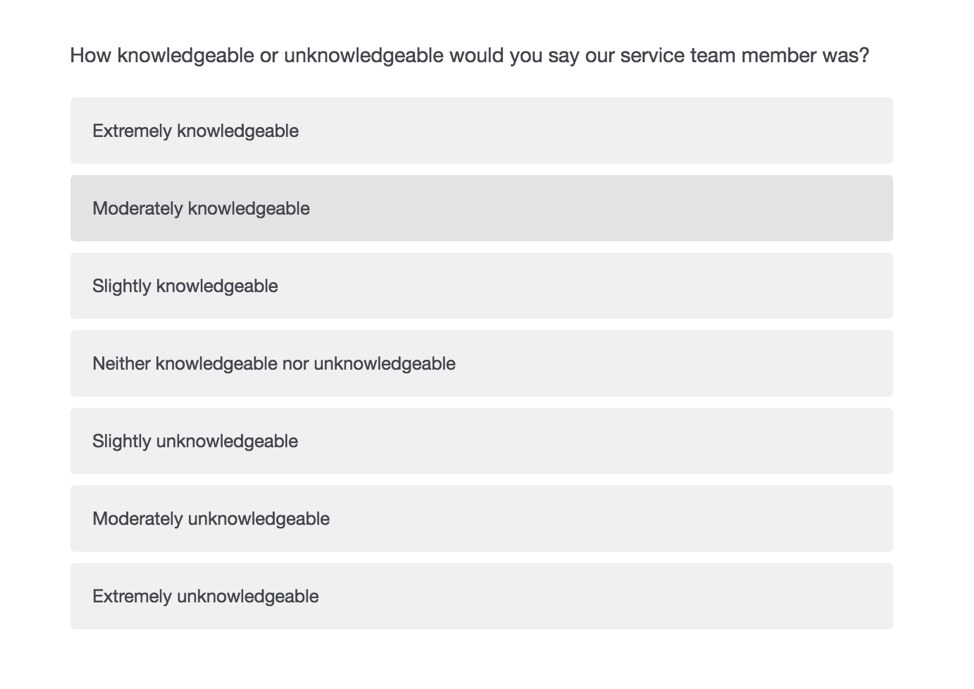
2. Channel-specific survey questions
Include channel-specific questions on a customer survey to assess which customer support channels are the most effective, and which channels need to be revised.
Your goal might be to have customers’ questions answered on the first attempt for a positive experience. The questions you ask will help you identify positive patterns or gaps in knowledge.
Examples of channel specific survey questions:
- Was this your first interaction with the [name of channel]?
- Would you use this channel again, based on your experience today?
- Were you able to locate what you were looking for on the channel?
- What other channels have you used in the past?
- Which specific channels do you like to use? (Customers can choose from options like live chat, call centre, mobile app, etc).
- How could we improve [name of channel], in your opinion?
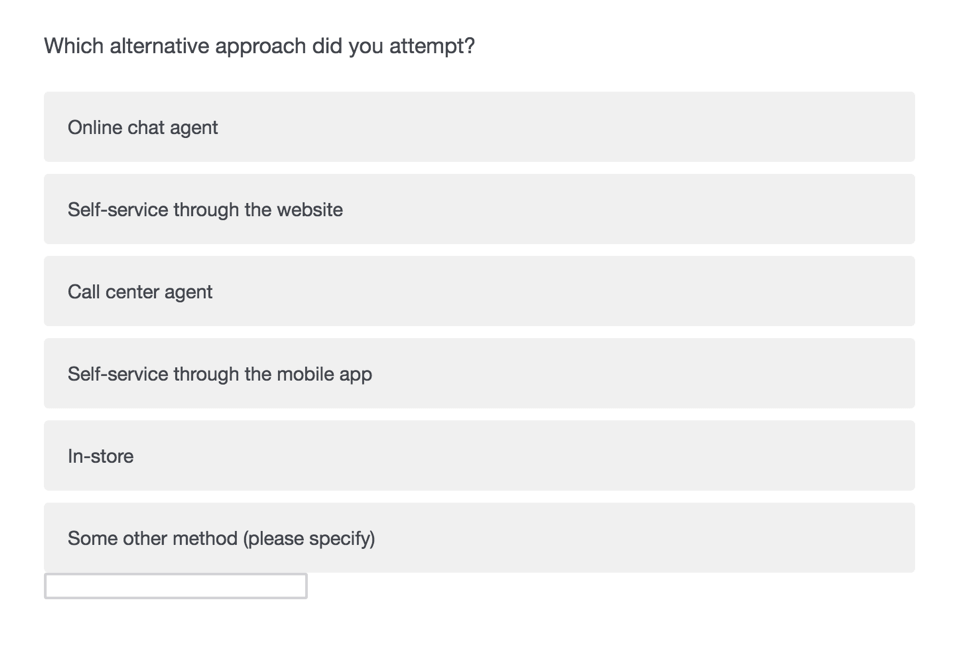
3. Customer Effort Score (CES) survey questions
Customer effort score (CES) survey questions understand how much effort the customer exerted to get their questions answered. The idea is that customers are more loyal to a product or service that is easier to use. CES surveys can be used immediately after interactions or specific touchpoints, like a product purchase or an interaction with customer service.
With the quantitative and qualitative data you gather, you can set goals, measure your performance over time, and see where you need to improve. The answers can tell you if a customer situation has been resolved, or if you need to take action to close the feedback loop fast. They can also help you understand where you stand among the competition.
Examples of questions on customer effort
- On a scale of ‘very easy’ to ‘very difficult’, how easy was it to interact with [company name]? What made your experience like that?
- Were you able to accomplish your goal today?
- If you needed to interact with an agent to accomplish your goal, did the agent fulfil your expectations?
- Did the service agent contact you to let you know your issue had been resolved?
- Is there anything else you’d like to share that could make your experience better?
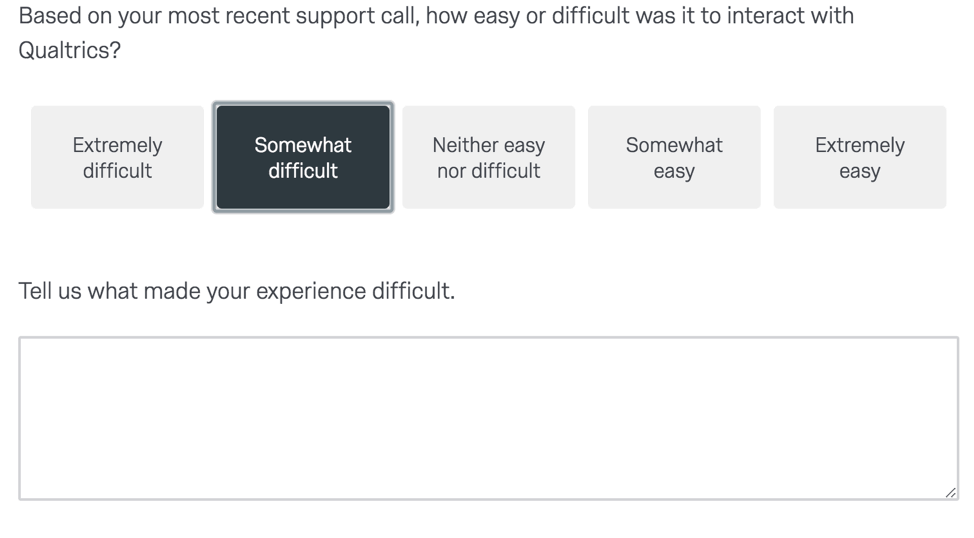
4. Customer satisfaction survey (CSAT) questions
Customer satisfaction (CSAT) surveys are used to understand your customer’s satisfaction levels with your organisation’s products, services, or experiences.
The questions can help understand your customer needs and understand problems with your products and/or services. A customer satisfaction score is a key metric when evaluating your performance with your customers. Continually collecting customer satisfaction score data can be helpful in understanding what you’re doing right for satisfied customers.
Rating scales are used to measure changes over time, and gain a deeper understanding of whether your business is meeting the customer’s expectations. Segmenting your satisfied customers and unhappy customers by creating customer satisfaction surveys helps you to spot trends and reasons behind a particular customer satisfaction score.
Examples of questions used in customer satisfaction surveys
- Overall, how satisfied were you with [company name or brand]?
- How often do you typically use our products or services? (A ‘Daily’ to ‘Do not use’ scale works best here)
- Based on your recent purchases, please rate your satisfaction with [a service or product attribute, like its value, purchase options, onboarding experience, etc]
- How would you rate your overall satisfaction with the [product/service] you received? (A Likert scale question between 1-5, with 5 being ‘highly satisfied’ and 1 being ‘highly unsatisfied’, works best here).
- How does the product or service help you achieve your goal?

5. Net Promoter Score (NPS) survey questions
The Net Promoter Score (NPS) survey question measures customer perception based on one simple question (below). It then provides customers with a chance to respond using a Likert scale from 0-10.
The beauty of a Net Promoter Score is that it requires only a simple question, and it’s simple to calculate your final NPS score from the results; by subtracting the percentage of detractors (people who responded with score between 0-6) from the percentage of promoters (people who responded with scores of 9 or 10). You want the final score to be as close to 100 as possible.
Long-term, this question can help you monitor positive change by measuring when detractors become promoters, which indicates that more of your customers have a higher appreciation for your brand.
Example of a recommendation-based question
- How likely is it that you would recommend [Organisation X/Product Y] to a friend or colleague?
- How likely is it that you would recommend our customer service to a friend or colleague?
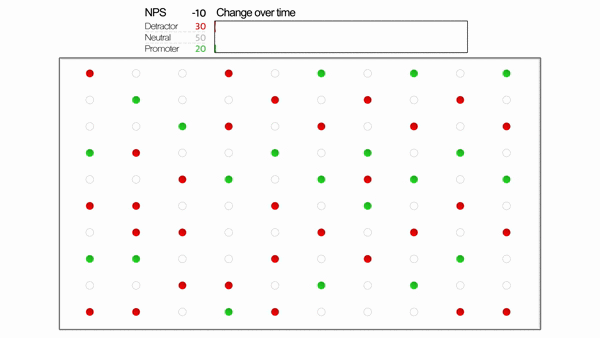
Types of customer survey questions
We’ve given some examples of customer service survey questions with a particular aim – but how you ask the question can also be important.
You might use:
Likert scale questions
This method of asking a query gives customers the option to show their agreement or disagreement with a set of statements. It demonstrates intensity of feeling, which can be helpful – and it’s a quick way for customers to feed back. However, it doesn’t give you much nuance when it comes to the “why” of a customer’s response.
Examples of Likert scale questions
- Overall, how satisfied were you with your buying experience today? [Very satisfied/Moderately satisfied/Neither satisfied nor dissatisfied/Moderately dissatisfied/Very dissatisfied]
- Our online purchase process was simple and straightforward. [Strongly agree/Agree/Disagree/Strongly disagree]
- Is having 24/7 customer service support important to you? [Very important/Important/Low importance/Not important]
Multiple choice questions
Survey respondents can pick their best choice from a provided list of answers. This can offer your customers a quick way to respond, making your survey easier to answer and lower effort. These can be particularly useful for demographic questions.
Examples of multiple choice questions
- Which of our products do you use in your daily life? Select as many answers as are relevant. [Beauty/Household/Clothing/Outdoor]
- Which of our customer support channels have you used in the past month? [Call centre/Live chat/Social media/SMS]
- How long have you been a customer with [Brand]? [0-2 years/2-5 years/5-10 years]
Questions with open text fields
Open text fields allow your customers to speak to you in their own voice with honest feedback, rather than selecting responses. This allows you to get responses you might not have considered, and better judge customer sentiment than a stock answer. This does require text analytics software to analyse at scale – however, this qualitative data is key to getting to the heart of customers’ opinions.
Examples of open text field questions
- What convinced you to sign up to our service?
- How could we have improved our service today?
- Why did you choose our product over our competitors?
- What is your main reason for using [Product/Service]?
When and how to send customer surveys
It can be easy to think that you should create customer surveys and send them off indiscriminately, but a targeted approach will help you to gather the right information for more valuable insights.
Read on to understand how to create your customer surveys, when to send them and how to follow up with action.
When to send customer experience surveys
When you send your customer surveys is an important part of the process. When you time your surveys at the right moment, it won’t feel like an intrusion – it will feel like you’re asking for their opinion and care about their thoughts. A well-timed survey will also improve the quality of the results you gather.
Often, the timing of the survey coincides with the questions you want to ask. For example:
- A customer satisfaction survey can be sent a few days after the purchase has been made, or if it’s a digital product, an in-app survey could be served during use. After a customer service interaction, a survey can be delivered in the communication channel used, such as live chat or email.
- A transactional NPS survey can be sent after an interaction in the customer journey (such as a purchase or a customer service call) on email on in-app
- A CES survey could be sent after a service sign up or product purchase as a web intercept (a pop-up) on the post-sign up or purchase screen
You might also send a customer survey at these regular intervals:
- After each customer interaction with a customer service representative
- After a service renewal
- After a service update
Ideally, you are continually sending customer feedback surveys to your paying customers.
The most comprehensive way to understand and improve the customer experience for your target audience is to capture feedback across all touchpoints where customer service is happening. This might be through interactive voice response (IVR) on customer calls, live chat, SMS, email and more, but every interaction is vital to capture and analyse for the most informative result.
How to send customer experience surveys
Delivering your customer feedback survey for the best result usually depends on what you’re asking, and which communication channels your customers prefer.
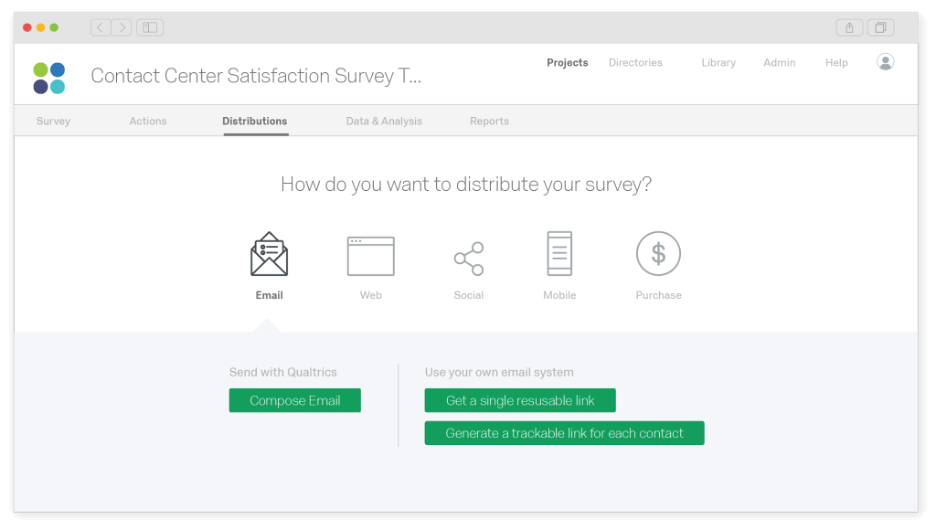
Your method of delivery might be:
- Email: Businesses often gather email data as part of the purchase process, making an email delivery system for a customer feedback survey quite simple. However, response rates can depend on day and time.
- SMS: Getting hold of customer telephone details can be harder than finding an email address or social media handle, but SMS is also a valid way of delivering a customer survey. Character count restrictions can be difficult to navigate, but this method delivers surveys more directly to the customer.
- Web intercept: Web intercepts (or pop ups that appear on web pages) are an effective way of delivering surveys, and are particularly useful when polling customers “in the moment” or directly after actions are taken.
- URL link: A URL link to a survey can be shared on all communication channels, making it easy to send on customers’ preferred channels.
You can also deliver surveys in-app, on chatbot and messaging apps, via messaging platforms and more. However, choosing which method to use can really depend on which channels customers use to interact with your brand and what you’re asking.
If you’re asking how hard a purchase was to make through a CES survey, it might not make sense to send a URL link to a social media handle, for example – but a URL link to a CSAT survey would be perfect to send this way if the customer had reached out to a customer service on social media.
Essentially, it’s important to think about the context of the survey delivery, and make a decision accordingly.
Best practice tips for collecting customer feedback
Keep your survey short – Just like you, customers don’t enjoy taking surveys or answering complicated questions. And the average person’s attention span is only 8 seconds long. You can respect your customer’s time and patience by keeping your survey short. Research has found that shorter is better as long as you’re getting the pertinent information, so it’s better to send out 2 shorter surveys than one long survey. Remember that you’ll be sending surveys throughout the customer lifecycle, so plan ahead for a larger number of shorter surveys.
Avoid asking unnecessary questions – Also, it’s best to avoid adding in questions you already know the answer to (like the agent’s name, the date the customer contacted you, what type of issue they had, what product they own, etc). Not only does this add time to a survey, it can make customers feel frustrated, and highlights that your company does not use their existing customer data in a managed and optimised way for communications. Focus only on the data that you need, not everything that you could possibly gather. It’s also important to only ask one question at a time – add in too many variables, and you can get a confusing answer or no answer at all.
Don’t ask leading questions – Leading questions can obscure the truth of a customer’s view on your brand, product or service, so avoiding them helps you to get a clear answer. An example of a leading question might be, “How great was your experience with [Brand] today?”, which might be better positioned as “How was your experience with [Brand] today?” for a more neutral approach to getting the same answer.
Make rating scales simple and consistent – If your Likert scale starts off as “1 = Really satisfied, 5 = Really dissatisfied” but then changes to “1 = Really dissatisfied, 5 = Really satisfied” midway through your customer service survey, you’re going to run into data issues later and muddle your results. How will you know which way your customers have answered the questions? Be clear across your rating scales and avoid losing customer interest during the survey – you also don’t want to have to repeat a survey when customer time has already been wasted.
Consider a pre-built solution to act faster – If you want the benefit of a smart customer experience management platform will be able to automatically keep track of this information, learn about Qualtrics Customer Survey Software. This allows you to focus on simply asking questions about your customer experience, and waiting for the results to be interpreted and delivered for you.
Act on your information in a structured, customer-centric way –When you have the customer data analysed, turn this information into actionable customer intelligence. This combines multi-channel information with a 360° view of the customer’s context and behaviour patterns, to help you understand why your target audience behaves in the way they do. This creates opportunities for better business decisions so you can act on what you learn. Without taking action, issues are left unaddressed and customer experiences can suffer – don’t let your data go to waste.
Get customer feedback that drives revenue
With Qualtrics Customer XM, you can gather customer feedback from every channel with well-timed customer feedback surveys that add to the customer experience. No matter where your customers are, gather data through targeted customer surveys and apply powerful analytics to the data you gather for better insights.
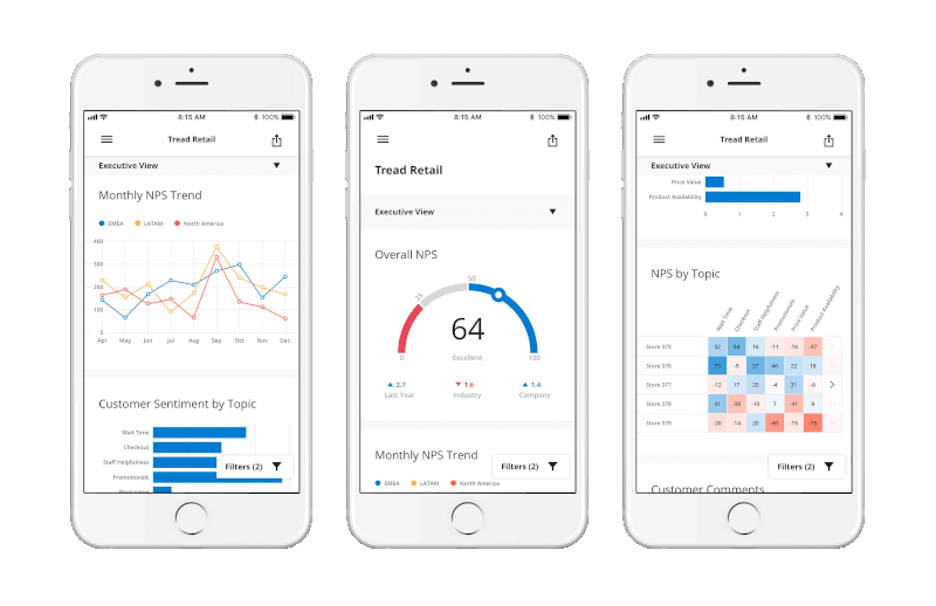
Create detailed profiles on your customers to help predict customer churn, and take action to improve key customer service metrics.
Discover How Qualtrics Customer Survey Software Can Improve Your Bottom Line